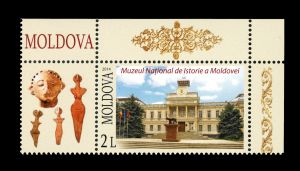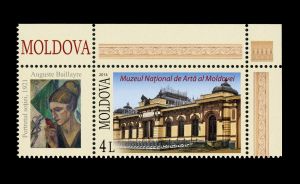Moldova 2014 "National Museums of the Republic of Moldova"
| << previous page | back to index | next page >> |
| Issue Date | 03.05.2014 |
| ID | Michel: 866-868; Scott: 821-823; Stanley Gibbons: 847-849; Yvert et Tellier: 753-755; Category: pR |
| Design | Alexandru Kornienco |
| Stamps in set | 3 |
| Value |
L1,20 - National Museum of Ethnography and Natural History L2,00 - National Museum of History L4,00 - National Museum of Fine Arts |
| Emission/Type | commemorative |
| Issue place | Chisinau |
| Size (width x height) | 46.00 mm x 27.50 mm |
| Layout | three Mini-Sheets of 10 stamps each with various labels |
| Products | FDC x 4 MC x3 |
| Paper | Coated (Glossy) |
| Perforation | 14 x 14.50 |
| Print Technique | Multicoloured, Offset Lithography |
| Printed by | Nova Imprim, Chisinau |
| Quantity | 20.000, 10.000, 10.000 |
| Issuing Authority | Ministere de la technologie de l’information et des communications Republique de Moldova |
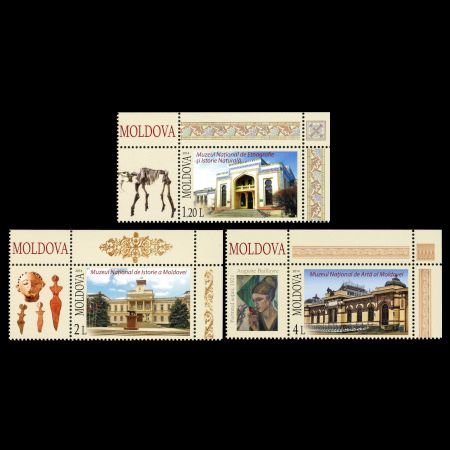
On May 3rd 2014, the Post of Moldova issued a set of stamps, showing three National Museums of the Republic of Moldova. These stamps were issued in Mini-Sheets of 10 stamps: five rows of two stamps with various labels in the middle. One of the labels of the Mini-Sheet of the National Museum of Ethnography and Natural History stamps sheet shows fossilized skeleton of Deinotherium giganteum from the museums collection. (In 1995 the Deinotherium appeared on post stamp of Moldova already).

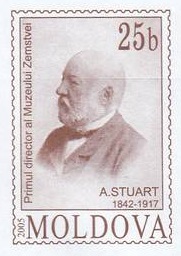 |
| Baron A. Stuart on imprinted stamp of postal stationary of Moldova 2005 |
Nowadays the museum is an important scientific and cultural center of Bessarabia which is also known abroad.
The museum is divided into 2 logical parts. The first one is dedicated to flora and fauna on the territory of Moldova. Here visitors can see the modern flora and fauna of the country and also how it looked many years ago, how nature has changed in Moldova. The history of natural development from Achaean till modern times is shown there. The other part of the museum is dedicated to people living on this territory, their customs and traditions. Here visitors see many ancient things which where used in every-day life. The history of how these items and technologies developed is also shown. Traditional costumes, interior of a house and the scene of local wedding are of great interest. The museum also has its own botanical garden which was started in 1906. It was the first botanical garden in Bessarabia and it exists till today.
 |
| Deinotherium giganteum on the entrance ticket of The National Museum of Ethnography and Natural History of Moldova |
Deinotherium ("terrible beast") was a large prehistoric relative of modern-day elephants that appeared in the Middle Miocene and survived until the Early Pleistocene. During that time it changed very little. In life, it probably resembled modern elephants, except that its trunk was shorter, and it had downward curving tusks attached to the lower jaw.
The way Deinotherium used its curious tusks has been much debated. It may have rooted in soil for underground plant parts like roots and tubers, pulled down branches to snap them and reach leaves, or stripped soft bark from tree trunks. Deinotherium fossils have been uncovered at several the African sites where remains of prehistoric hominid relatives of modern humans have also been found. Deinotherium's range covered parts of Asia, Africa, and Europe. Adrienne Mayor, in The First Fossil Hunters: Paleontology In Greek and Roman Times, has suggested that deinothers fossils found in Greece helped generate myths of archaic giant beings.
Related philatelic materials
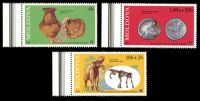 |
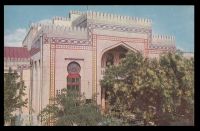 |
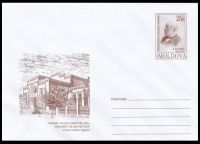 |
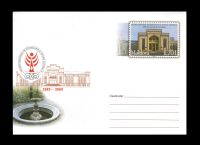 |
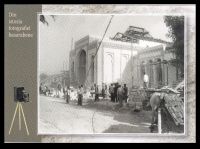 |
Products and associated philatelic items
| FDC | Mini-Sheets | |
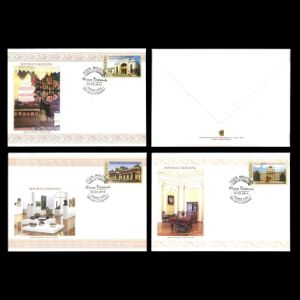 |
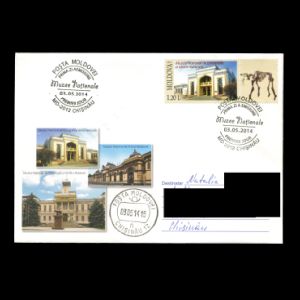 |
 |
| Examples of circulated covers | ||
 |
 |
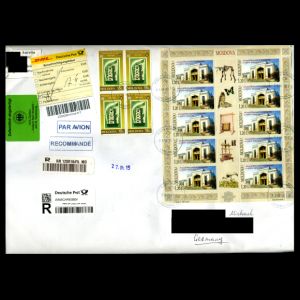 |
| Maxi Cards | ||
 |
|
|
| The reverse side is here | ||

|
References
WorldOfMoldova, MoldovaStamps.org, Wikipedia.Acknowledgements
Many thanks to Dr. Peter Voice from Department of Geological and Environmental Sciences, Western Michigan University, for reviewing the draft page and his valuable comments.| << previous page | back to index | next page >> |
